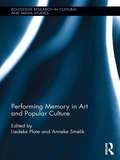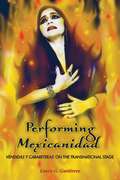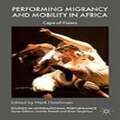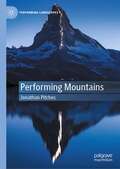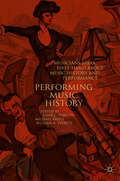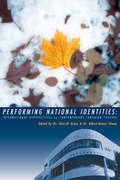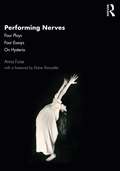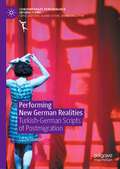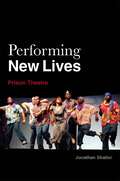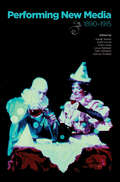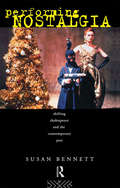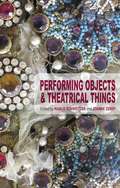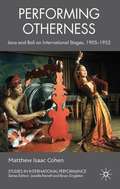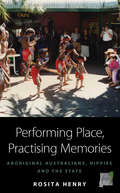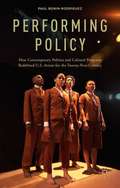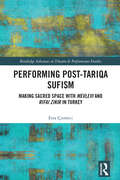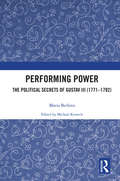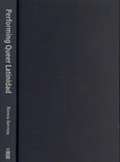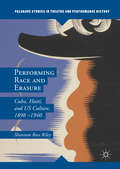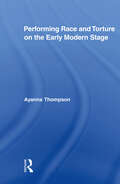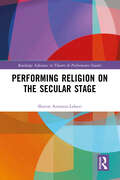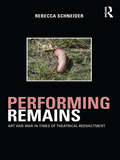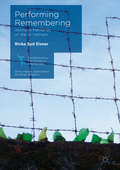- Table View
- List View
Performing Memory in Art and Popular Culture (Routledge Research in Cultural and Media Studies)
by Liedeke Plate Anneke SmelikThis volume pursues a new line of research in cultural memory studies by understanding memory as a performative act in art and popular culture. The authors take their cue from the observation that art and popular culture enact memory and generate processes of memory. They do memory, and in this doing of memory new questions about the cultural dimensions of memory arise: How do art objects and artistic practices perform the past in the present? What is their relationship to the archive? Does the past speak in the performed past (or do we speak to it)? To what purpose do objects "recall"? And for whom do they recollect? Here authors combine a methodological focus on memory as performance with a theoretical focus on art and popular culture as practices of remembrance. The essays in the book thus analyze what is at stake in the complex processes of remembering and forgetting, of recollecting and disremembering, of amnesia and anamnesis, that make up cultural memory.
Performing Mexicanidad: Vendidas y Cabareteras on the Transnational Stage
by Laura G. GutiérrezUsing interdisciplinary performance studies and cultural studies frameworks, Laura G. Gutiérrez examines the cultural representation of queer sexuality in the contemporary cultural production of Mexican female and Chicana performance and visual artists.<P> In particular, she locates the analytical lenses of feminist theory and queer theory in a central position to interrogate Mexican female dissident sexualities in transnational public culture. <P><P> This is the first book-length study to wed performance studies and queer theory in examining the performative/performance work of important contemporary Mexicana and Chicana cultural workers. It proposes that the creations of several important artists—Chicana visual artist Alma López; the Mexican political cabareteras Astrid Hadad, Jesusa Rodríguez, Liliana Felipe, and Regina Orozco; the Chicana performance artist Nao Bustamante; and the Mexican video artist Ximena Cuevas—unsettle heterosexual national culture. In doing so, they are not only challenging heterosexist and nationalist discourses head-on, but are also participating in the construction of a queer world-making project. Treating the notion of dis-comfort as a productive category in these projects advances feminist and queer theories by offering an insightful critical movement suggesting that queer worlds are simultaneously spaces of desire, fear, and hope.
Performing Migrancy and Mobility in Africa
by Mark FleishmanPerforming Migrancy and Mobility in Africa focuses on a body of performance work, the work of Magnet Theatre in particular but also work by other artists in Cape Town and other parts of the continent or the world, that engages with the Cape as a real or imagined node in a complex system of migration and mobility. Located at the foot of the African continent, lodged between two oceans at the intersection of many of the earth's major shipping lanes, Cape Town is a stage for a powerful mixing of cultures and peoples and has been an important node in a network of flows, circuits of movement and exchange. The performance works studied here attempt to get to grips with what it feels like to be on the move and in the spaces in-between that characterises the lives, now and for centuries before, of multiple peoples who move around and pass through places like the Cape. The contributors are a broad range of mostly African authors from various parts of the continent and as such the book offers an insight into new thinking and new approaches from an emerging and important location.
Performing Mountains (Performing Landscapes)
by Jonathan PitchesLaunching the landmark Performing Landscapes series, Performing Mountains brings together for the first time Mountain Studies and Performance Studies in order to examine an international selection of dramatic responses to mountain landscapes. Moving between different registers of writing, the book offers a critical assessment of how the cultural turn in landscape studies interacts with the practices of environmental theatre and performance. Conceived in three main parts, it begins by unpicking the layers of disciplinary complexity in both fields, before surveying the rich history and practice of rituals, playtexts and site specific works inspired by mountains. The last section moves to a unique analysis of mountains themselves using key concepts from performance: training, scenography, acting and spectatorship. Threaded throughout is a very personal tale of mountain research, offering a handrail or alternative guide through the book.
Performing Music History: Musicians Speak First-Hand about Music History and Performance
by John C. Tibbetts William A. Everett Michael SafflePerforming Music History offers a unique perspective on music history and performance through a series of conversations with women and men intimately associated with music performance, history, and practice: the musicians themselves. Fifty-five celebrated artists—singers, pianists, violinists, cellists, flutists, horn players, oboists, composers, conductors, and jazz greats—provide interviews that encompass most of Western music history, from the Middle Ages to contemporary classical music, avant-garde innovations, and Broadway musicals. The book covers music history through lenses that include “authentic” performance, original instrumentation, and social context. Moreover, the musicians interviewed all bring to bear upon their respective subjects three outstanding qualities: 1) their high esteem in the music world as immediately recognizable names among musicians and public alike; 2) their energy and devotion to scholarship and the recovery of endangered musical heritages; and 3) their considerable skills, media savvy, and showmanship as communicators. Introductory essays to each chapter provide brief synopses of historical eras and topics. Combining careful scholarship and lively conversation, Performing Music History explores historical contexts for a host of fascinating issues.
Performing National Identities
by Sherrill Grace Albert-Reiner GlaapA collection of eighteen original essays on contemporary Canadian theatre by scholars and drama specialists in Canada, Great Britain, Europe, Australia, Hungary, and Japan. The international scope of the volume, reflected in its co-editors (Sherrill Grace from Canada, Albert-Reiner Glaap from Germany), confirms the new importance of Canadian plays on the world stage.
Performing Nerves: Four Plays, Four Essays, On Hysteria
by Anna FurseAcademic interest in hysteria has burgeoned in recent decades. The topic has been probed by feminist theorists, cultural studies specialists, literary scholars, anthropologists, sociologists, psychologists, medical and art historians, as well as novelists. The hysteric is construed as a powerless, voiceless subject, marginalised by the forces of the patriarchy that have been the root cause of their distress, dissembling, and disablement. In Performing Nerves, Anna Furse interweaves her artistic and academic practice, drawing on her own performance texts to explore four different versions of debilitating hysteric suffering. Each text is extensively annotated, revealing the dramaturgical logic and, in turn, the historical, medical, and cultural contexts behind their protagonists' illnesses, which are argued as environmentally caused in each case. This unique, reflective insight into a playwright and director’s craft offers not only an account of how mental suffering can manifest in different contexts and times, from the 19th century to today, but also a breadth of access to the ideas that can motivate creative research. This book is an invaluable resource for scholars of theatre studies, performance studies, dramaturgy, 20th-century history, gender studies, and medical humanities.
Performing New German Realities: Turkish-German Scripts of Postmigration (Contemporary Performance InterActions)
by Lizzie Stewart'One in four people in Germany today have a so-called migration background, however, the relationship between theatre and migration there has only recently begun to take centre stage. Indeed, fifty years after large-scale Turkish labour migration to the Federal Republic of Germany began, theatre by Turkish-German artists is only now becoming a consistent feature of Germany’s influential state-funded theatrical landscape. Drawing on extensive archival and field work, this book asks where, when, why, and how plays engaging with the new realities of “postmigrant” Germany have been performed over the past 30 years. Focusing on plays by renowned artists Emine Sevgi Özdamar, and Feridun Zaimoglu/Günter Senkel, it asks which new realities have been scripted in the theatrical sphere in the process – in the imaginations of playwrights, readers, audience members; in the enactment and direction of scripts on stage; and in the performance of new institutional approaches and cultural policies. Highlighting the role this theatre has played in a larger, ongoing re-scripting of the German stage, this study presents a critical perspective on contemporary European theatre and opens innovative developments in the conceptualization of theatre and post/migration from the German context to English language readers.
Performing New Lives
by Jonathan ShailorPerforming New Lives draws together some of the most original and innovative programs in contemporary prison theatre. Leading prison theatre directors and practitioners discuss the prison theatre experience first-hand, and offer valuable insights into its role, function, and implementation. A wide range of prison theatre initiatives are discussed, from long-running, high-profile programs such as Curt Tofteland's "Shakespeare Behind Bars" in LaGrange, Kentucky, to fledgling efforts like Jodi Jinks' "ArtsAloud" project in Austin, Texas. The book offers unique insights into the many dimensions of the prison theatre experience, including: negotiating the rules and restrictions of the prison environment; establishing trust, teaching performance skills and managing crises; building relationships and dealing with conflicts; and negotiating public performances and public perceptions. Excerpts of interviews with inmates, and a conversation between practitioners in the final chapter, reveal the impact that prison theatre programs have on the performers themselves, as well as audience members, and the wider community. Exploring prison theatre processes and theory with insights into how it works in practice, and how to replicate it, this book is essential reading for drama therapists, theatre artists, and prison educators, as well as academics.
Performing New Media, 1890–1915 (Early Cinema In Review: Proceedings Of Domitor Ser.)
by Louis Pelletier Tami Williams Frank Gray Scott Curtis Kaveh Askari Joshua YumibeEssays examining the effects of media innovations in cinema at the turn of the twentieth century affected performances on screen, as well as beside it.In the years before the First World War, showmen, entrepreneurs, educators, and scientists used magic lanterns and cinematographs in many contexts and many venues. To employ these silent screen technologies to deliver diverse and complex programs usually demanded audio accompaniment, creating a performance of both sound and image. These shows might include live music, song, lectures, narration, and synchronized sound effects provided by any available party—projectionist, local talent, accompanist or backstage crew—and would often borrow techniques from shadow plays and tableaux vivants. The performances were not immune to the influence of social and cultural forces, such as censorship or reform movements. This collection of essays considers the ways in which different visual practices carried out at the turn of the twentieth century shaped performances on and beside the screen.
Performing Nostalgia: Shifting Shakespeare and the Contemporary Past
by Susan BennettIn this trenchant work, Susan Bennett examines the authority of the past in modern cultural experience and the parameters for the reproduction of the plays. She addresses these issues from both the viewpoints of literary theory and theatre studies, shifting Shakespeare out of straightforward performance studies in order to address questions about his plays and to consider them in the context of current theoretical debates on historiography, post-colonialism and canonicity.
Performing Objects and Theatrical Things
by Marlis Schweitzer Joanne ZerdyThis book rethinks historical and contemporary theatre, performance, and cultural events by scrutinizing and theorizing the objects and things that activate stages, venues, environments, and archives.
Performing Orthodox Ritual in Byzantium
by Andrew Walker WhiteIn this groundbreaking, interdisciplinary study, Andrew Walker White explores the origins of Byzantine ritual - the rites of the early Greek Orthodox Church - and its unique relationship with traditional theatre. Tracing the secularization of pagan theatre, the rise of rhetoric as an alternative to acting, as well as the transmission of ancient methods of musical composition into the Byzantine era, White demonstrates how Christian ritual was in effect a post-theatrical performing art, created by intellectuals who were fully aware of traditional theatre but who endeavoured to avoid it. The book explores how Orthodox rites avoid the aesthetic appreciation associated with secular art, and conducts an in-depth study (and reconstruction) of the late Byzantine Service of the Furnace. Often treated as a liturgical drama, White translates and delineates the features of five extant versions, to show how and why it generated widely diverse audience reactions in both medieval times and our own.
Performing Otherness
by Matthew Isaac CohenA far-reaching examination of exoticism, cultural internationalism and modernism's encounters with Indonesian tradition, Performing Otherness examines how Indonesia entered world stages through imperialism as an antimodern phantasm and through nationalism became a means of intercultural communication and cultural diplomacy.
Performing Place, Practising Memories
by Rosita HenryDuring the 1970s a wave of 'counter-culture' people moved into rural communities in many parts of Australia. This study focuses in particular on the town of Kuranda in North Queensland and the relationship between the settlers and the local Aboriginal population, concentrating on a number of linked social dramas that portrayed the use of both public and private space. Through their public performances and in their everyday spatial encounters, these people resisted the bureaucratic state but, in the process, they also contributed to the cultivation and propagation of state effects.
Performing Policy
by Paul Bonin-RodriguezPerforming Policy explains how a movement in cultural policy that began in the 1990s redefined US artists' roles in society and enhanced their prospects for the twenty-first century. In the first years of the century, a series of landmark reports appeared, significantly expanding the nation's understanding of the relevance of arts to everyday life. Broadly, these reports covered issues of changing tastes and consumption habits, the relevance of culture to economic and social stability in communities, and the challenges facing artists and arts organizations in the new economy. Their publication coincided with a number of national initiatives that proposed and modelled new methods of artistic practice and sustainability. Analyzing the political origins and practical applications of recent advancements in arts policy, this book demonstrates how the redefining of artists took place and to what ends. At the same time, Performing Policy proposes a new definition through which artists might be productively acknowledged as co-creators of the nation's arts infrastructure.
Performing Post-Tariqa Sufism: Making Sacred Space with Mevlevi and Rifai Zikir in Turkey (Routledge Advances in Theatre & Performance Studies)
by Esra ÇizmeciThis ethnographic research project examines the generation of post-tariqa Tasavvuf (Sufism: a spiritual practice and philosophy recognised as the inner dimension of Islam) in a variety of private, semi-public, public, secular and sacred urban spaces in present-day Turkey. Through extensive field research in minority Sufi communities, this book investigates how devotees of specific orders maintain, adapt, mobilise, and empower their beliefs and values through embodied acts of their Sufi followers. Using an ethnographic methodology and theories derived from performance studies, Esra Çizmeci examines the multiple ways in which the post-tariqa Mevlevi and Rifai practice is formed in present-day Turkey, such as through the authority of the spiritual teacher; the individual and collective performance of Sufi rituals; nefs (self) training; and, most importantly, the practice of Sufi doctrines in everyday life through the production of sacred spaces. Drawing on the theories of performance, she examines how the Sufi way of living and spaces are created anew in the process of each devotee’s embodied action. This book is informed by theories in performance studies, anthropology, religious studies, and cultural studies and places current Sufi practices in a historical perspective.
Performing Power: The Political Secrets of Gustav III (1771-1792)
by Maria BerlovaPerforming Power explores 18th-century fabrication of the royal image by focusing on the example of King Gustav III (1746–1792) – one of Sweden’s most acclaimed and controversial monarchs – who conspicuously chose theater as the primary media for his image-making and role construction. The text postulates that Gustav III was motivated by theater’s ability to aid him in fulfilling Enlightenment’s tenet of broadly educating the populace and inculcating it with royal ideology. That he was an amateur actor, stage director, and playwright were other engines driving his choice. The project challenges and expands the commonly accepted perception of Gustav III’s contribution to Swedish theater, which has generally been limited to founding its National Opera, developing its national drama, and forming its national dramatic repertoire. Maria Berlova presents Gustav III as a performing King who strategically used political events as a framework through which he could embody the image of the ideal or enlightened monarch as presented by Voltaire. Through this, Performing Power explores the tight relationship and complex bond between theatrical arts and politics. This unique study will be of great interest to students and scholars in theater studies, 18th-century culture, and politics.
Performing Queer Latinidad: Dance, Sexuality, Politics
by Rivera-Servera Ramón H.Performing Queer Latinidad highlights the critical role that performance played in the development of Latina/o queer public culture in the United States during the 1990s and early 2000s, a period when the size and influence of the Latina/o population was increasing alongside a growing scrutiny of the public spaces where latinidad could circulate. Performances---from concert dance and street protest to the choreographic strategies deployed by dancers at nightclubs---served as critical meeting points and practices through which LGBT and other nonnormative sex practitioners of Latin American descent (individuals with greatly differing cultures, histories of migration or annexation to the United States, and contemporary living conditions) encountered each other and forged social, cultural, and political bonds. At a time when latinidad ascended to the national public sphere in mainstream commercial and political venues and Latina/o public space was increasingly threatened by the redevelopment of urban centers and a revived anti-immigrant campaign, queer Latinas/os in places such as the Bronx, San Antonio, Austin, Phoenix, and Rochester, NY, returned to performance to claim spaces and ways of being that allowed their queerness and latinidad to coexist. These social events of performance and their attendant aesthetic communication strategies served as critical sites and tactics for creating and sustaining queer latinidad.
Performing Race and Erasure
by Shannon Rose RileyIn this book, Shannon Rose Riley provides a critically rich investigation of representations of Cuba and Haiti in US culture in order to analyze their significance not only to the emergence of empire but especially to the reconfiguration of US racial structures along increasingly biracial lines. Based on impressive research and with extensive analysis of various textual and performance forms including a largely unique set of skits, plays, songs, cultural performances and other popular amusements, Riley shows that Cuba and Haiti were particularly meaningful to the ways that people in the US re-imagined themselves as black or white and that racial positions were renegotiated through what she calls acts of palimpsest: marking and unmarking, racing and erasing difference. Riley's book demands a reassessment of the importance of the occupations of Cuba and Haiti to US culture, challenging conventional understandings of performance, empire, and race at the turn of the twentieth century.
Performing Race and Torture on the Early Modern Stage (Routledge Studies in Renaissance Literature and Culture #9)
by Ayanna ThompsonPerforming Race and Torture on the Early Modern Stage provides the first sustained reading of Restoration plays through a performance theory lens. This approach shows that an analysis of the conjoined performances of torture and race not only reveals the early modern interest in the nature of racial identity, but also how race was initially coded in a paradoxical fashion as both essentially fixed and socially constructed. An examination of scenes of torture provides the most effective way to unearth these seemingly contradictory representations of race because depictions of torture often interrogate the incongruous desire to substitute the visible and manipulable materiality of the body for the more illusive performative nature of identity. In turn, Performing Race and Torture on the Early Modern Stage challenges the long-standing assumption that early modern conceptions of race were radically different in their fluidity from post-Enlightenment ones by demonstrating how many of the debates we continue to have about the nature of racial identity were engendered by these seventeenth-century performances.
Performing Religion on the Secular Stage (Routledge Advances in Theatre & Performance Studies)
by Sharon Aronson-LehaviThis book examines the relations between Western religion, secularism, and modern theater and performance. Sharon Aronson-Lehavi posits that the ongoing cultural power of religious texts, icons, and ideas on the one hand and the artistic freedom enabled by secularism and avant-garde experimentalism on the other, has led theatre artists throughout the twentieth century to create a uniquely modern theatrical hybrid–theater performances that simultaneously re-inscribe and grapple with religion and religious performativity. The book compares this phenomenon with medieval forms of religious theater and offers deep and original analyses of significant contemporary works ranging from plays and performances by August Strindberg, Hugo Ball (Dada), Jerzy Grotowski, and Hanoch Levin, to those created by Adrienne Kennedy, Rina Yerushalmi, Deb Margolin, Milo Rau, and Sarah Ruhl. The book analyzes a new and original historiography of a uniquely modern theatrical phenomenon, a study that is of high importance considering the reemergence of religion in contemporary culture and politics.
Performing Remains: Art and War in Times of Theatrical Reenactment
by Rebecca Schneider'At last, the past has arrived! Performing Remains is Rebecca Schneider's authoritative statement on a major topic of interest to the field of theatre and performance studies. It extends and consolidates her pioneering contributions to the field through its interdisciplinary method, vivid writing, and stimulating polemic. Performing Remains has been eagerly awaited, and will be appreciated now and in the future for its rigorous investigations into the aesthetic and political potential of reenactments.' - Tavia Nyong'o, Tisch School of the Arts, New York University 'I have often wondered where the big, important, paradigm-changing book about re-enactment is: Schneider’s book seems to me to be that book. Her work is challenging, thoughtful and innovative and will set the agenda for study in a number of areas for the next decade.' - Jerome de Groot, University of Manchester Performing Remains is a dazzling new study exploring the role of the fake, the false and the faux in contemporary performance. Rebecca Schneider argues passionately that performance can be engaged as what remains, rather than what disappears. Across seven essays, Schneider presents a forensic and unique examination of both contemporary and historical performance, drawing on a variety of elucidating sources including the "America" plays of Linda Mussmann and Suzan-Lori Parks, performances of Marina Abramovic´ and Allison Smith, and the continued popular appeal of Civil War reenactments. Performing Remains questions the importance of representation throughout history and today, while boldly reassessing the ritual value of failure to recapture the past and recreate the "original."
Performing Remembering: Women's Memories of War in Vietnam (Contemporary Performance InterActions)
by Rivka Syd EisnerThis book explores the performances and politics of memory among a group of women war veterans in Ho Chi Minh City, Vietnam. Through ethnographic, oral history-based research, it connects the veterans’ wartime histories, memory politics, performance practices, recollections of imprisonment and torture, and social activism with broader questions of how to understand and attend to continuing transgenerational violence and trauma. With an extensive introduction and subsequent chapters devoted to in-depth analysis of four women’s remarkable life stories, the book explores the performance and performativity of culture; ethnographic oral history practice; personal, collective, and (trans)cultural memory; and the politics of postwar trauma, witnessing, and redress. Through the veterans’ dynamic practices of prospective remembering, 'pain-taking', and enduring optimism, it offers new insights into matrices of performance vital to the shared work of social transformation. It will appeal to readers interested in performance studies, memory studies, gender studies, Vietnamese studies, and oral history.
Performing Resilience for Systemic Pain (Routledge Advances in Theatre & Performance Studies)
by Meghan Moe BeitiksHow might performance serve as a means for facing ubiquitous trauma and pain, in humans and ecologies? While reflecting on her multidisciplinary work Systems of Pain/Networks of Resilience, artist Meghan Moe Beitiks considers bodies of knowledge in Trauma Theory, Intersectional Feminist Philosophy, Ecology, Disability Studies, New Materialism, Object-Oriented Ontology, Gender Studies, Artistic Research, Psychology, Performance Studies, Social Justice, Performance Philosophy, Performance Art, and a series of first-person interviews in an attempt to answer that question. Beitiks brings us through the first-person process of making the work and the real-life, embodied encounters with the theories explored within it as an expansion of the work itself. Facing down difficult issues like trauma, discrimination, and the vulnerability of the body, Beitiks looks to commonalities across species and disciplines as means of developing resilience and cultivating communities. Rather than paint a picture of glorious potential utopias, Beitiks takes a hard look at herself as an embodiment of the values explored in the work, and stays with the difficult, sucky, troubling, work to be done. Performing Resilience for Systemic Pain is a vulnerable book about the quiet presence and hard looking needed to shift systems away from their oppressive, destructive realities.
